Climate Pressures on Intangible Heritage
Abstract
1. Introduction
1.1. Intangible Heritage
- Oral traditions and expressions, including language as a vehicle of intangible cultural heritage;
- Performing arts;
- Social practices, rituals, and festive events;
- Knowledge and practices concerning nature and the universe;
- Traditional craftsmanship.
1.2. Assessing Climate Change Impacts
1.3. Data-Driven Approach
2. Materials, Data, and Methods
2.1. Data Sources
2.2. Metrics
- What meteorological conditions would prevent humans from being able to perform a given activity required for intangible heritage to be practiced and passed on?
- What conditions are needed for the environment or setting to be conducive for intangible cultural heritage?
- What conditions would hinder the availability of key resources needed for intangible heritage?
3. Results and Examples
3.1. Oral Traditions and Expressions
3.2. Performing Arts
3.3. Social Practices, Rituals, and Festive Events
3.4. Knowledge and Practices Concerning Nature and the Universe
3.5. Traditional Craftsmanship
4. Discussion
4.1. Climate Interface with Intangible Heritage
- The setting or landscape that serves as a context for the heritage, as seen with the need for clement weather conditions for festivals to take place and cool climates for sports such as ice skating. Thus, intangible cultural heritage is influenced by the setting or landscape in which the practices take place.
- The physical resources required, e.g., climate and weather can affect the physical resources needed for intangible heritage, e.g., the growth and collection of the flax needed for basket weaving.
- People’s actions. Weather events can affect people’s actions, as seen with unpredictable rain affecting rainmaking practices and extreme heat curtailing sporting events.
4.2. Climate Processes
4.3. Managing Intangible Heritage in Changing Climates
5. Conclusions
Author Contributions
Funding
Data Availability Statement
Conflicts of Interest
Correction Statement
References
- Colette, A. Case Studies on Climate Change and World Heritage; UNESCO Publishing: Paris, France, 2013. [Google Scholar]
- Sesana, E.; Gagnon, A.S.; Ciantelli, C.; Cassar, J.; Hughes, J.J. Climate change impacts on cultural heritage: A literature review. Wiley Interdiscip. Rev. Clim. Change 2021, 12, e710. [Google Scholar]
- Aboulnaga, M.; Abouaiana, A.; Puma, P.; Elsharkawy, M.; Farid, M.; Gamal, S.; Lucchi, E. Climate change and cultural heritage: A global mapping of the UNESCO thematic indicators in conjunction with advanced technologies for cultural sustainability. Sustainability 2024, 16, 4650. [Google Scholar] [CrossRef]
- Cacciotti, R.; Sardella, A.; Drdácký, M.; Bonazza, A. A methodology for vulnerability assessment of cultural heritage in extreme climate changes. Int. J. Disaster Risk Sci. 2024, 15, 404–420. [Google Scholar] [CrossRef]
- Orr, S.A.; Richards, J.; Fatorić, S. Climate change and cultural heritage: A systematic literature review (2016–2020). Hist. Environ. Policy Pract. 2021, 12, 434–477. [Google Scholar]
- UNESCO. Intangible Heritage Domains in the 2003 Convention. 2003. Available online: https://ich.unesco.org/en/intangible-heritage-domains-00052 (accessed on 21 April 2025).
- Wulf, C. Handbook on Intangible Cultural Practices as Global Strategies for the Future (Chapter 1); Springer Nature: Berlin/Heidelberg, Germany, 2024. [Google Scholar]
- Iacono, V.L.; Brown, D.H. Beyond binarism: Exploring a model of living cultural heritage for dance. Danc. Res. 2016, 34, 84–105. [Google Scholar]
- Upadhyay, R.K. Markers for global climate change and its impact on social, biological and ecological systems: A review. Am. J. Clim. Change 2020, 9, 159–203. [Google Scholar]
- Adger, W.N.; Barnett, J.; Chapin, F.S., III; Ellemor, H. This must be the place: Underrepresentation of identity and meaning in climate change decision-making. Glob. Environ. Politics 2011, 11, 1–25. [Google Scholar]
- Harrison, K. Indigenous music sustainability during climate change. Curr. Opin. Environ. Sustain. 2020, 43, 28–34. [Google Scholar] [CrossRef]
- UNESCO. MONDIACULT 2022 Ministerial Declaration Final Declaration. The UNESCO World Conference on Cultural Policies and Development Will Be Hosted by the Government of Mexico from 28 to 30 September 2022. Available online: https://www.unesco.org/en/mondiacult/2022 (accessed on 21 April 2025).
- Labadi, S.; Giliberto, F.; Rosetti, I.; Shetabi, L.; Yildirim, E. Heritage and the Sustainable Development Goals: Policy Guidance for Heritage and Development Actors; ICOMOS: Paris, France, 2021; pp. 1–16. Available online: https://kar.kent.ac.uk/89231/1/ICOMOS_SDGs_Policy_Guidance_2021.pdf (accessed on 17 September 2025).
- Laime, S.; Balcare, K.; Gailīte, E.; Grīnvalde, R.; Vaivade, A. Perspectives on Climate Change Impact on Intangible Cultural Heritage: The Case of Traditional Lamprey Fishing in Latvia. Anthropol. J. Eur. Cult. 2024, 33, 26–36. [Google Scholar]
- Richards, J.; Brimblecombe, P. The transfer of heritage modelling from research to practice. Her. Sci. 2022, 10, 17. [Google Scholar]
- Brimblecombe, P.; Richards, J. Applied climatology for heritage. Theor. Appl. Climatol. 2024, 155, 7325–7333. [Google Scholar] [CrossRef]
- Richards, J.; Brimblecombe, P. Tuning and effectiveness in heritage models. Heritage 2023, 6, 5516–5523. [Google Scholar] [CrossRef]
- World Bank. Climate Change Knowledge Portal. 2025. Available online: https://climateknowledgeportal.worldbank.org/ (accessed on 21 April 2025).
- Cooper, J. Rescue, Archival and Stewardship of Weather Records and Data. 2015. Available online: https://wmo.int/media/magazine-article/rescue-archival-and-stewardship-of-weather-records-and-data (accessed on 21 May 2025).
- Richards, J.; Brimblecombe, P. Moisture as a driver of long-term threats to timber heritage—Part I: Changing heritage climatology. Heritage 2022, 5, 1929–1946. [Google Scholar] [CrossRef]
- Ottenheimer, H. The Anthropology of Language: An Introduction To Linguistic Anthropology; Wadsworth Cengage Learning: Belmont, CA, USA, 2009; pp. 129–145. [Google Scholar]
- Macfarlane, R. The Lost Words: A Spell Book; Publisher Anansi International: Toronto, ON, Canada, 2018. [Google Scholar]
- Woodlands Trust. Common Beech. 28 February 2025. Available online: https://www.woodlandtrust.org.uk/trees-woods-and-wildlife/british-trees/a-z-of-british-trees/common-beech/ (accessed on 17 September 2025).
- Martinez del Castillo, E.; Zang, C.S.; Buras, A.; Hacket-Pain, A.; Esper, J.; Serrano-Notivoli, R.; Hartl, C.; Weigel, R.; Klesse, S.; Resco de Dios, V.; et al. Climate-change-driven growth decline of European beech forests. Commun. Biol. 2022, 5, 163. [Google Scholar] [CrossRef] [PubMed]
- Yu, J.; Berry, P.; Guillod, B.P.; Hickler, T. Climate change impacts on the future of forests in Great Britain. Front. Environ. Sci. 2021, 9, 640530. [Google Scholar] [CrossRef]
- Wang, H.; Lin, S.; Dai, J.; Ge, Q. Modeling the effect of adaptation to future climate change on spring phenological trend of European beech (Fagus sylvatica L.). Sci. Total Environ. 2022, 846, 157540. [Google Scholar] [CrossRef]
- Skogvang, B.O. Development of cultural and environmental awareness through Sámi outdoor life at Sámi/Indigenous festivals. Front. Sports Act. Living 2021, 3, 662929. [Google Scholar] [CrossRef]
- Pager-McClymont, K. A stylistic model of the converse of pathetic fallacy. Lang. Lit. 2024, 33, 44–68. [Google Scholar] [CrossRef]
- Hulme, M. ‘Telling a different tale’: Literary, historical and meteorological readings of a Norfolk heatwave. Clim. Change 2012, 113, 5–21. [Google Scholar] [CrossRef]
- Brimblecombe, P. Documentary records. In Global Change in the Holocene; Routledge: London, UK, 2014; pp. 159–167. [Google Scholar]
- Adamson, G.C. Private diaries as information sources in climate research. Wiley Interdiscip. Rev. Clim. Change 2015, 6, 599–611. [Google Scholar] [CrossRef]
- García-Herrera, R.; Barriopedro, D.; Gallego, D.; Mellado-Cano, J.; Wheeler, D.; Wilkinson, C. Understanding weather and climate of the last 300 years from ships’ logbooks. Wiley Interdiscip. Rev. Clim. Change 2018, 9, e544. [Google Scholar] [CrossRef]
- Aranuvachapun, S.; Brimblecombe, P. Tawatodsamad Klongdun-an old Thai weather poem. Weather 1979, 34, 459–464. [Google Scholar] [CrossRef]
- Khan, S.; Thornes, J.E.; Baker, J.; Olson, D.W.; Doescher, R.L. Monet at the Savoy. Area 2010, 42, 208–216. [Google Scholar] [CrossRef]
- Green, B.; Strong, C. ‘What if it rains? What if there are bushfires?’: Extreme weather, climate change and music festivals in Australia. Media Int. Aust. 2025, 195, 120–136. [Google Scholar] [CrossRef]
- Gibson, C. Music festivals: Transformations in non-metropolitan places, and in creative work. Media Int. Aust. 2007, 123, 65–81. [Google Scholar] [CrossRef]
- Spracklen, D.V.; Mickley, L.J.; Logan, J.A.; Hudman, R.C.; Yevich, R.; Flannigan, M.D.; Westerling, A.L. Impacts of climate change from 2000 to 2050 on wildfire activity and carbonaceous aerosol concentrations in the western United States. J. Geophys. Res. Atmos. 2009, 114, D20301. [Google Scholar] [CrossRef]
- City of Sydney, Energy and Climate Change. 2024. Available online: https://www.cityofsydney.nsw.gov.au/environmental-action/energy-and-climate-change (accessed on 3 May 2024).
- Dean, A.; Green, D. Climate change, air pollution and human health in Sydney, Australia: A review of the literature. Environ. Res. Lett. 2018, 13, 053003. [Google Scholar] [CrossRef]
- Herath, S.M.; Sarukkalige, R. Evaluation of empirical relationships between extreme rainfall and daily maximum temperature in Australia. J. Hydrol. 2018, 556, 1171–1181. [Google Scholar] [CrossRef]
- O’Malley, E. “To weather a play”: Audiences, Outdoor Shakespeares, and Avant-Garde Nostalgia at The Willow Globe. Shakespear. Bull. 2018, 36, 409–427. [Google Scholar] [CrossRef]
- O’Malley, E.M. The Natural Place for the Play: Outdoor Shakespeares, Environment, and an Ethnography of Audience Experience. Ph.D. Thesis, University of Exeter (United Kingdom), Exeter, UK, 2016. [Google Scholar]
- Luckman, S. Location, spatiality and liminality at outdoor music festivals: Doofs as journey. In The Festivalization of Culture; Routledge: London, UK, 2016; pp. 189–206. [Google Scholar]
- Kramer, P. Dancing Materiality. Ph.D. Thesis, Coventry University, Coventry, UK, 2015. [Google Scholar]
- Stanyukovich, M.V. A living shamanistic oral tradition: Ifugao hudhud, the Philippines. Oral Tradit. 2003, 18, 249–251. [Google Scholar] [CrossRef]
- Post, E.; Alley, R.B.; Christensen, T.R.; Macias-Fauria, M.; Forbes, B.C.; Gooseff, M.N.; Iler, A.; Kerby, J.T.; Laidre, K.L.; Mann, M.E.; et al. The polar regions in a 2 C warmer world. Sci. Adv. 2019, 5, eaaw9883. [Google Scholar] [CrossRef]
- Damyanov, N.N.; Matthews, H.D.; Mysak, L.A. Observed decreases in the Canadian outdoor skating season due to recent winter warming. Environ. Res. Lett. 2012, 7, 014028. [Google Scholar] [CrossRef]
- United Nations Climate Change, Global Climate Action. Sports for Climate Action Framework (Version 2.0). December 2018. Available online: https://unfccc.int/sites/default/files/resource/Sports_for_Climate_Action_Declaration_and_Framework.pdf (accessed on 17 September 2025).
- Brocherie, F.; Girard, O.; Millet, G.P. Emerging environmental and weather challenges in outdoor sports. Climate 2015, 3, 492–521. [Google Scholar] [CrossRef]
- Knowles, N.; Scott, D.; Steiger, R. Winter sports and climate change. In Sport and Environmental Sustainability; Routledge: London, UK, 2020; pp. 140–161. [Google Scholar]
- Brammer, J.R.; Samson, J.; Humphries, M.M. Declining availability of outdoor skating in Canada. Nat. Clim. Change 2014, 5, 2–4. [Google Scholar] [CrossRef]
- Wobus, C.; Small, E.E.; Hosterman, H.; Mills, D.; Stein, J.; Rissing, M.; Jones, R.; Duckworth, M.; Hall, R.; Kolian, M.; et al. Projected climate change impacts on skiing and snowmobiling: A case study of the United States. Glob. Environ. Change 2017, 45, 1–14. [Google Scholar] [CrossRef]
- Liu, J.; Cheng, H.; Sun, X.; Huang, L.; Fan, Q.; Liu, H. Effects of climate change on outdoor skating in the Bei Hai Park of Beijing and related adaptive strategies. Sustainability 2017, 9, 1147. [Google Scholar] [CrossRef]
- Visser, H.; Petersen, A.C. The likelihood of holding outdoor skating marathons in the Netherlands as a policy-relevant indicator of climate change. Clim. Change 2009, 93, 39–54. [Google Scholar] [CrossRef]
- Richards, J. Modelling the impact of climate change on cultural practices: The future of fen skating (1981–2079). Reg. Environ. Change 2024, 24, 61. [Google Scholar] [CrossRef]
- Mason, H.; Peden, A.; Leicht, A.; King, J.; Franklin, R. Extreme Heat Is a Killer for Outdoor Sporting Events—Let’s Plan Properly to Keep Everyone Safe. The Conversation. 2024. Available online: https://theconversation.com/extreme-heat-is-a-killer-for-outdoor-sporting-events-lets-plan-properly-to-keep-everyone-safe-229998 (accessed on 29 January 2025).
- Wimbledon 2024. Heat Rule. 28 February 2025. Available online: https://www.wimbledon.com/en_GB/about_wimbledon/heat_rule.html (accessed on 29 January 2025).
- Tennis Australia. Heat Stress Scale a Grand Slam First. 2018. Available online: https://ausopen.com/articles/news/ao-heat-stress-scale-grand-slam-first (accessed on 29 January 2025).
- Lawn Tennis Association. Extreme Heat Policy—LTA Competition Regulations; LTA: London, UK, 2022. [Google Scholar]
- Bujisic, M.; Bogicevic, V.; Parsa, H.G. The effect of weather factors on restaurant sales. J. Foodserv. Bus. Res. 2017, 20, 350–370. [Google Scholar] [CrossRef]
- Agnew, M.D.; Thornes, J.E. The weather sensitivity of the UK food retail and distribution industry. Meteorol. Appl. 1995, 2, 137–147. [Google Scholar] [CrossRef]
- Waite, J.L. A time and a place for ice cream. Geogr. Teach. 2020, 17, 104–108. [Google Scholar] [CrossRef]
- Ziady, H. The World’s Biggest Ice Cream Company Says Heat Waves May Not Help Sales. CBS News. Available online: https://www.cbsnews.com/sacramento/news/the-worlds-biggest-ice-cream-company-says-heat-waves-may-not-help-sales/ (accessed on 12 May 2025).
- Yezli, S.; Khan, A.; Bouchama, A. Summer Hajj pilgrimage in the era of global warming: A call for vigilance and better understanding of the risks. J. Travel Med. 2019, 26, taz069. [Google Scholar] [CrossRef] [PubMed]
- Saeed, F.; Schleussner, C.F.; Almazroui, M. From Paris to Makkah: Heat stress risks for Muslim pilgrims at 1.5 C and 2 C. Environ. Res. Lett. 2021, 16, 024037. [Google Scholar] [CrossRef]
- Tomatis, F. Analysis of possible repercussions of climate change on the Camino de Santiago Francés (“French Way”) as it passes throught Castilla y León (Spain). Rev. Interam. Ambiente Tur. 2020, 16, 202–216. [Google Scholar] [CrossRef]
- Brimblecombe, P.; Tola, H.G.; Richards, J. Climate change and pilgrimage to shrines in Ethiopia. Heritage 2023, 7, 95–106. [Google Scholar] [CrossRef]
- Hong, Z.; Slingerland, E.; Henrich, J. Magic and empiricism in early Chinese rainmaking: A cultural evolutionary analysis. Curr. Anthropol. 2024, 65, 343–363. [Google Scholar] [CrossRef]
- Forth, G. Making fun of animals: Ontological implications of rituals and taboos observed in geographically and linguistically discontinuous regions of Southeast Asia and southwestern China. Oceania 2022, 92, 267–286. [Google Scholar] [CrossRef]
- Christian, N.G. The impact of climate change on African traditional religious practices. J. Earth Sci. Clim. Change 2014, 5, 1–5. [Google Scholar] [CrossRef]
- Koufos, G.; Mavromatis, T.; Koundouras, S.; Fyllas, N.M.; Jones, G.V. Viticulture-climate relationships in Greece: The impacts of recent climate trends on harvest date variation. Int. J. Climatol. 2014, 34, 1445–1459. [Google Scholar] [CrossRef]
- Olesen, J.E.; Børgesen, C.D.; Elsgaard, L.; Palosuo, T.; Rötter, R.P.; Skjelvåg, A.O.; Peltonen-Sainio, P.; Börjesson, T.; Trnka, M.; Ewert, F.; et al. Changes in time of sowing, flowering and maturity of cereals in Europe under climate change. Food Addit. Contam. Part A 2012, 29, 1527–1542. [Google Scholar] [CrossRef]
- Prochnow, A.; Risius, H.; Hoffmann, T.; Chmielewski, F.M. Does climate change affect period, available field time and required capacities for grain harvesting in Brandenburg, Germany? Agric. For. Meteorol. 2015, 203, 43–53. [Google Scholar] [CrossRef]
- Waha, K.; Müller, C.; Bondeau, A.; Dietrich, J.P.; Kurukulasuriya, P.; Heinke, J.; Lotze-Campen, H. Adaptation to climate change through the choice of cropping system and sowing date in sub-Saharan Africa. Glob. Environ. Change 2013, 23, 130–143. [Google Scholar] [CrossRef]
- Waongo, M.; Laux, P.; Kunstmann, H. Adaptation to climate change: The impacts of optimized planting dates on attainable maize yields under rainfed conditions in Burkina Faso. Agric. For. Meteorol. 2015, 205, 23–39. [Google Scholar] [CrossRef]
- Raymundo, R.; Asseng, S.; Robertson, R.; Petsakos, A.; Hoogenboom, G.; Quiroz, R.; Hareau, G.; Wolf, J. Climate change impact on global potato production. Eur. J. Agron. 2018, 100, 87–98. [Google Scholar] [CrossRef]
- Gyedu, A.K.; Damptey, F.G.; Barnes, V.R.; Bentsi-Enchill, F.; Sarfo, D.A.; Mohammed, I.; Opuni-Frimpong, E. Multiple Anthropogenic and Climatic Factors Drive Tree Species Attributes in Ecologically Distinct Sacred Groves in Ghana. Int. J. For. Res. 2025, 2025, 9944297. [Google Scholar] [CrossRef]
- UNESCO. Elements Inscribed in 2021 on the Representative List of the Intangible Cultural Heritage of Humanity. 2021. Available online: https://ich.unesco.org/en/RL/flower-carpets-tradition-for-corpus-christi-processions-01743 (accessed on 27 May 2025).
- Available online: https://aulis.org/EnglishCalendar/#ecclesiastical (accessed on 24 May 2025).
- Damalas, C.A.; Koutroubas, S.D.; Fotiadis, S. Phenological development of natural populations of European field pansy (Viola arvensis) in a semi-arid Mediterranean environment. Plant Species Biol. 2018, 33, 212–220. [Google Scholar] [CrossRef]
- Jardine, M.I. Blooming dates. Landsc. Archit. 1924, 14, 270–278. [Google Scholar]
- Brimblecombe, P.; Hayashi, M. Pressures from long term environmental change at the shrines and temples of Nikkō. Herit. Sci. 2018, 6, 27. [Google Scholar] [CrossRef]
- Dziubata-Smykowska, K. Local Responses to Climate Change Impact on Intangible Cultural Heritage in Poland. Lit. Ludowa 2024, 68, 61–82. [Google Scholar] [CrossRef]
- Charles, J.G.; Allan, D.J. Development of the willow sawfly, Nematus oligospilus, at different temperatures, and an estimation of voltinism throughout New Zealand. N. Z. J. Zool. 2000, 27, 197–200. [Google Scholar] [CrossRef][Green Version]
- Kopp, R.F.; Abrahamson, L.P.; White, E.H.; Volk, T.A.; Nowak, C.A.; Fillhart, R.C. Willow biomass production during ten successive annual harvests. Biomass Bioenergy 2001, 20, 1–7. [Google Scholar] [CrossRef]
- Oltean, I.; Hulujan, I.; Hulujan, I.; Varga, M.; Tötös, Ş.; Florian, T. Cydalima Perspectalis Walker (Lepidoptera, Crambidae) a New Dangerous Pest Report on Buxus Sempervirens in Cluj Area. Bulletin of the University of Agricultural Sciences & Veterinary Medicine Cluj-Napoca. Agriculture 2017, 74, 26–36. [Google Scholar]
- Geci, D.; Musliu, M.; Bilalli, A.; Ibrahimi, H. New records of Cydalima perspectalis (Walker, 1859)(Lepidoptera, Crambidae) from Albania and Kosovo. Natura Croatica: Periodicum Musei Historiae Naturalis Croatici 2020, 29, 135–138. [Google Scholar] [CrossRef]
- Skonieczna-Gawlik, D. Rośliny w zwyczajach i obrzędach mieszkańców województwa śląskiego. Rocznik Muzeum „Górnośląski Park Etnograficzny w Chorzowie” 2015, 3, 103–123. [Google Scholar]
- Zadro, M.G. Woods used for woodwind instruments since the 16th century—1. Early Music 1975, 3, 134–136. [Google Scholar] [CrossRef]
- GBIF Secretariat: GBIF Backbone Taxonomy. Available online: https://www.gbif.org/species/4532122 (accessed on 13 March 2025).
- Sohngen, B.; Mendelsohn, R.; Sedjo, R. A global model of climate change impacts on timber markets. J. Agric. Resour. Econ. 2001, 26, 326–343. [Google Scholar]
- Kherais, M.; Csébfalvi, A.; Len, A. The climate impact on timber structures. Int. J. Optim. Civ. Eng. 2021, 11, 143–154. [Google Scholar]
- López Campos, L.I.; Prestileo, F.; Stella, E.M.; Mascitelli, A.; Aruffo, E.; Chiacchiaretta, P.; Di Carlo, P.; Dietrich, S. Heritage Resilience and Identity: Lesson from Trabocchi Coast about Climate Change Adaptation Strategies. Sustainability 2024, 16, 5848. [Google Scholar] [CrossRef]
- Nikkanen, M.; Räsänen, A.; Juhola, S. The influence of socioeconomic factors on storm preparedness and experienced impacts in Finland. Int. J. Disaster Risk Reduct. 2021, 55, 102089. [Google Scholar] [CrossRef]
- Grossi, C.M.; Brimblecombe, P.; Menéndez, B.; Benavente, D.; Harris, I.; Déqué, M. Climatology of salt transitions and implications for stone weathering. Sci. Total Environ. 2011, 409, 2577–2585. [Google Scholar] [CrossRef]
- Muñoz-González, C.M.; León-Rodríguez, A.L.; Navarro-Casas, J. Air conditioning and passive environmental techniques in historic churches in Mediterranean climate. A proposed method to assess damage risk and thermal comfort pre-intervention, simulation-based. Energy Build. 2016, 130, 567–577. [Google Scholar] [CrossRef]
- Cui, X.; Xie, W. Adapting agriculture to climate change through growing season adjustments: Evidence from corn in China. Am. J. Agric. Econ. 2022, 104, 249–272. [Google Scholar] [CrossRef]
- Sakurai, R.; Jacobson, S.K.; Kobori, H.; Primack, R.; Oka, K.; Komatsu, N.; Machida, R. Culture and climate change: Japanese cherry blossom festivals and stakeholders’ knowledge and attitudes about global climate change. Biol. Conserv. 2011, 144, 654–658. [Google Scholar] [CrossRef]
- Richards, J.; Brimblecombe, P. Climate metrics for modelling conditions on pilgrimages in Ethiopia. Herit. Sci. 2025, in press. [Google Scholar]
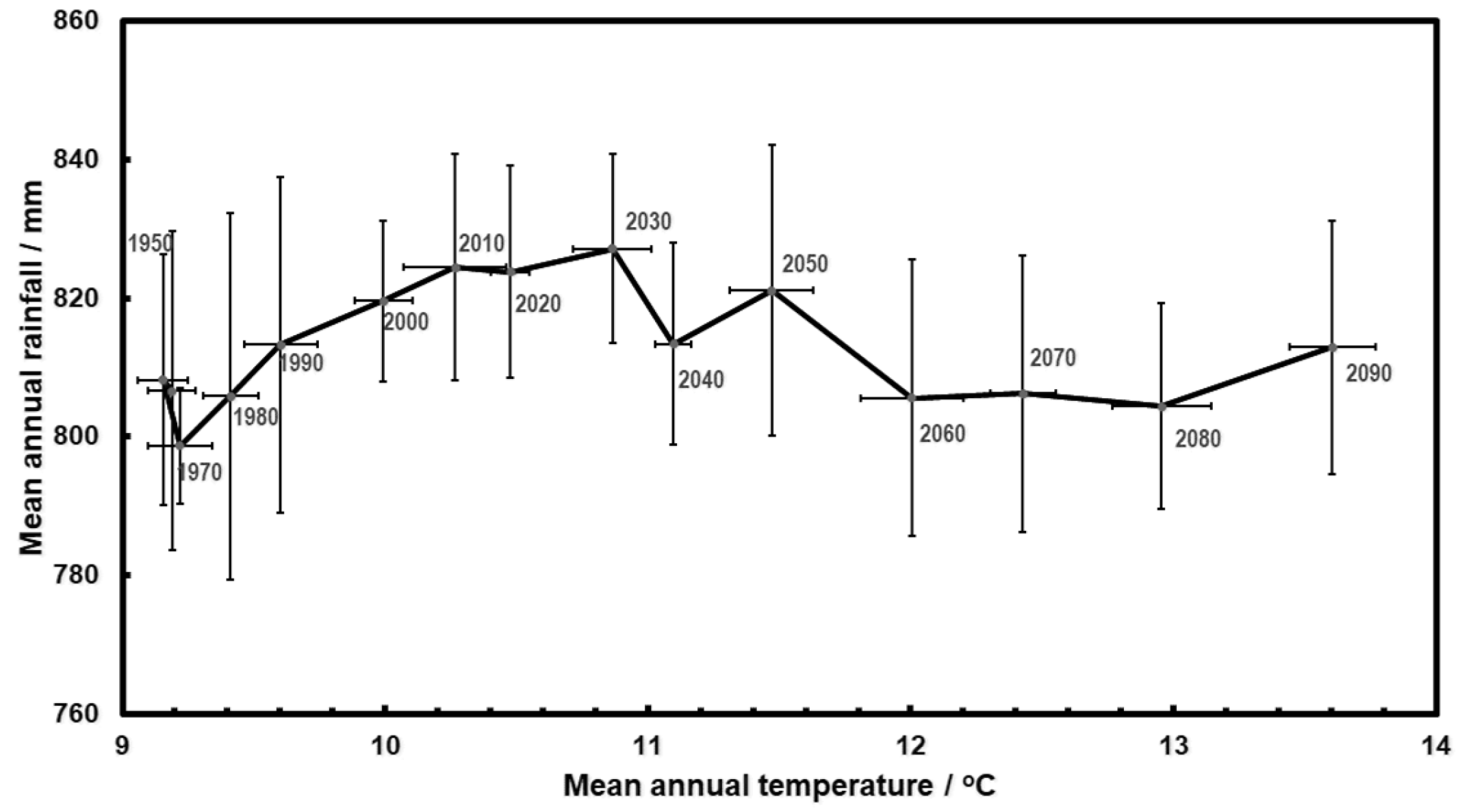
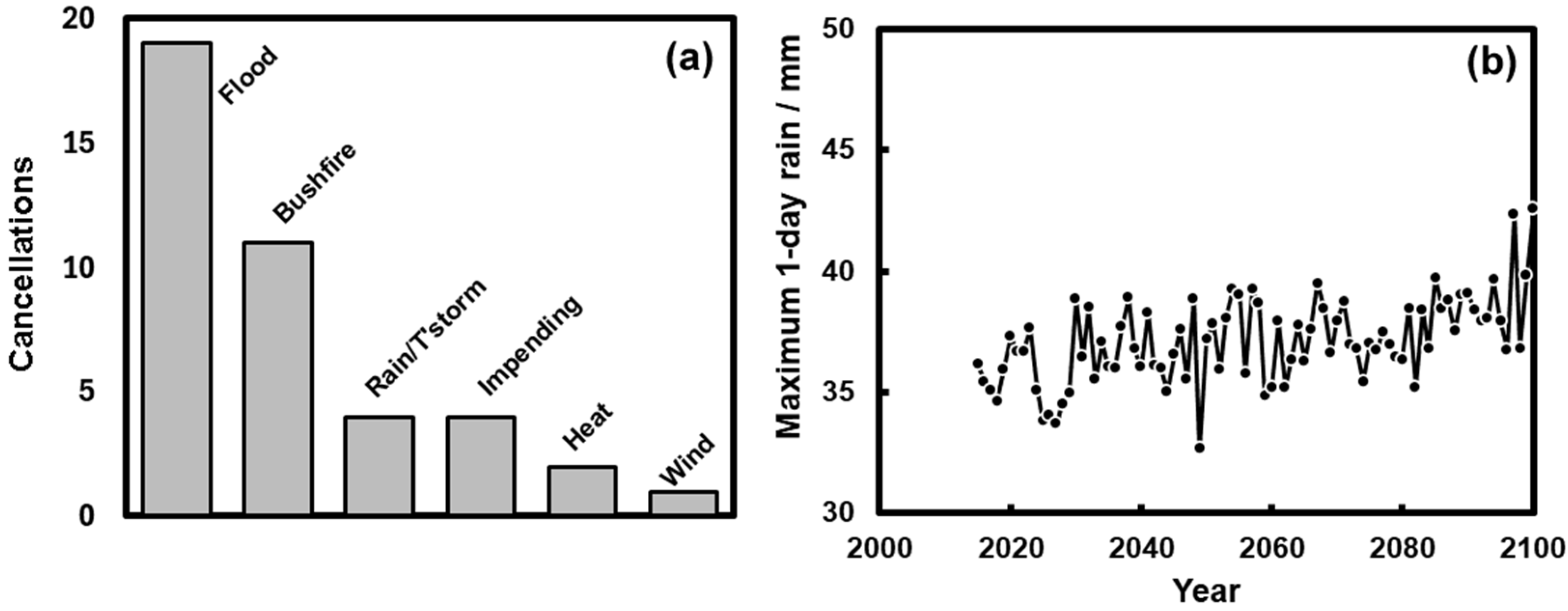
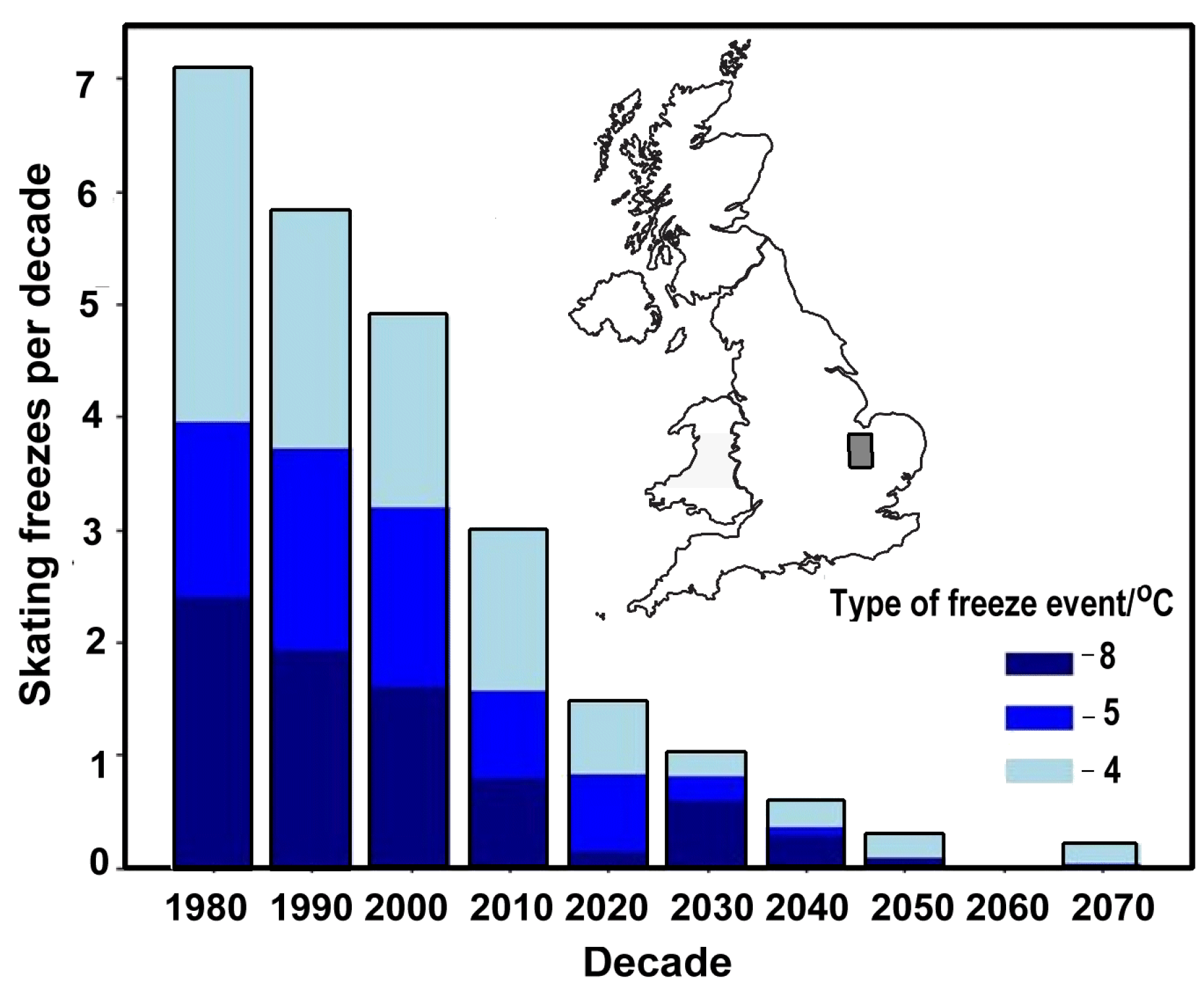
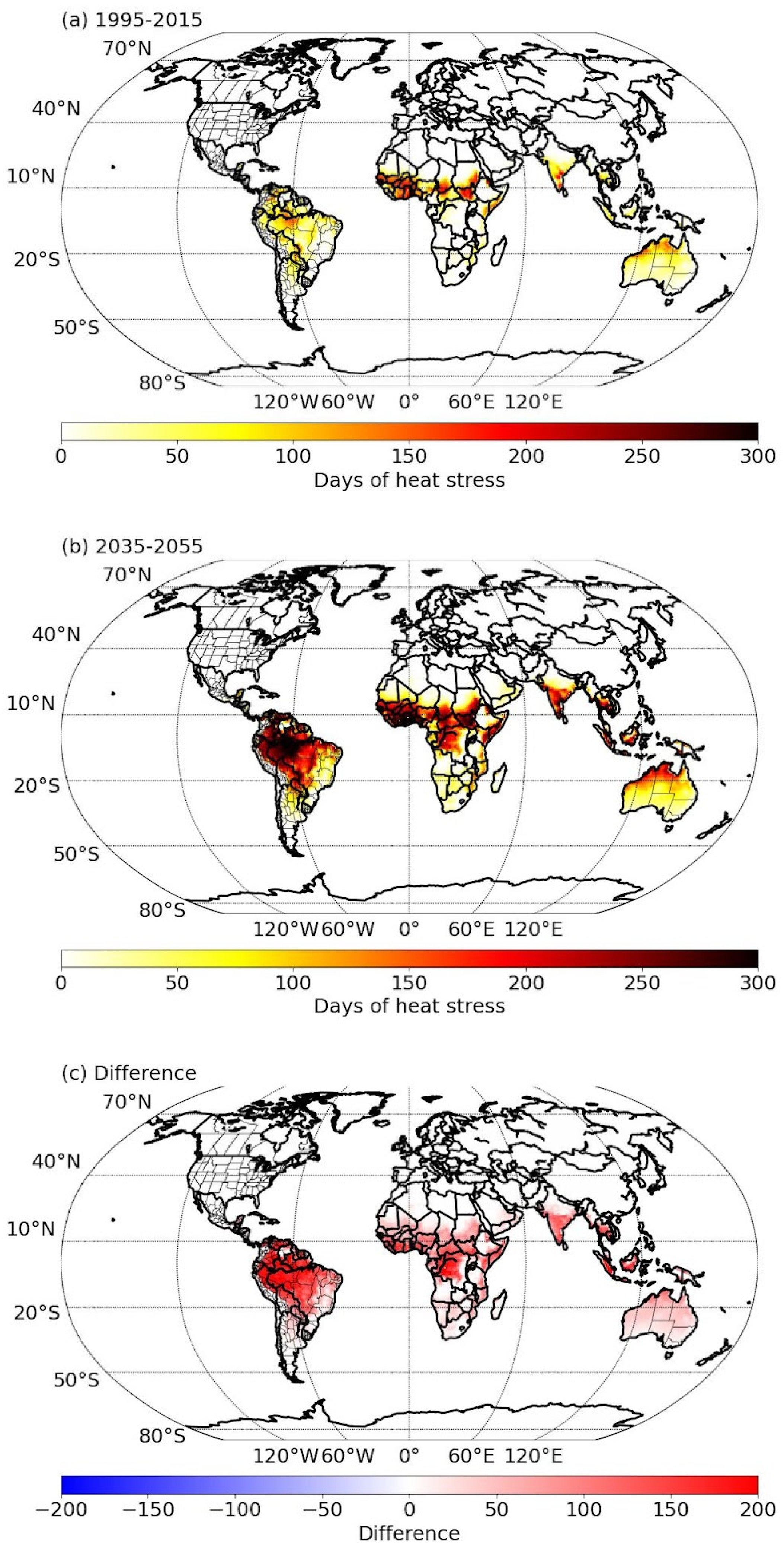


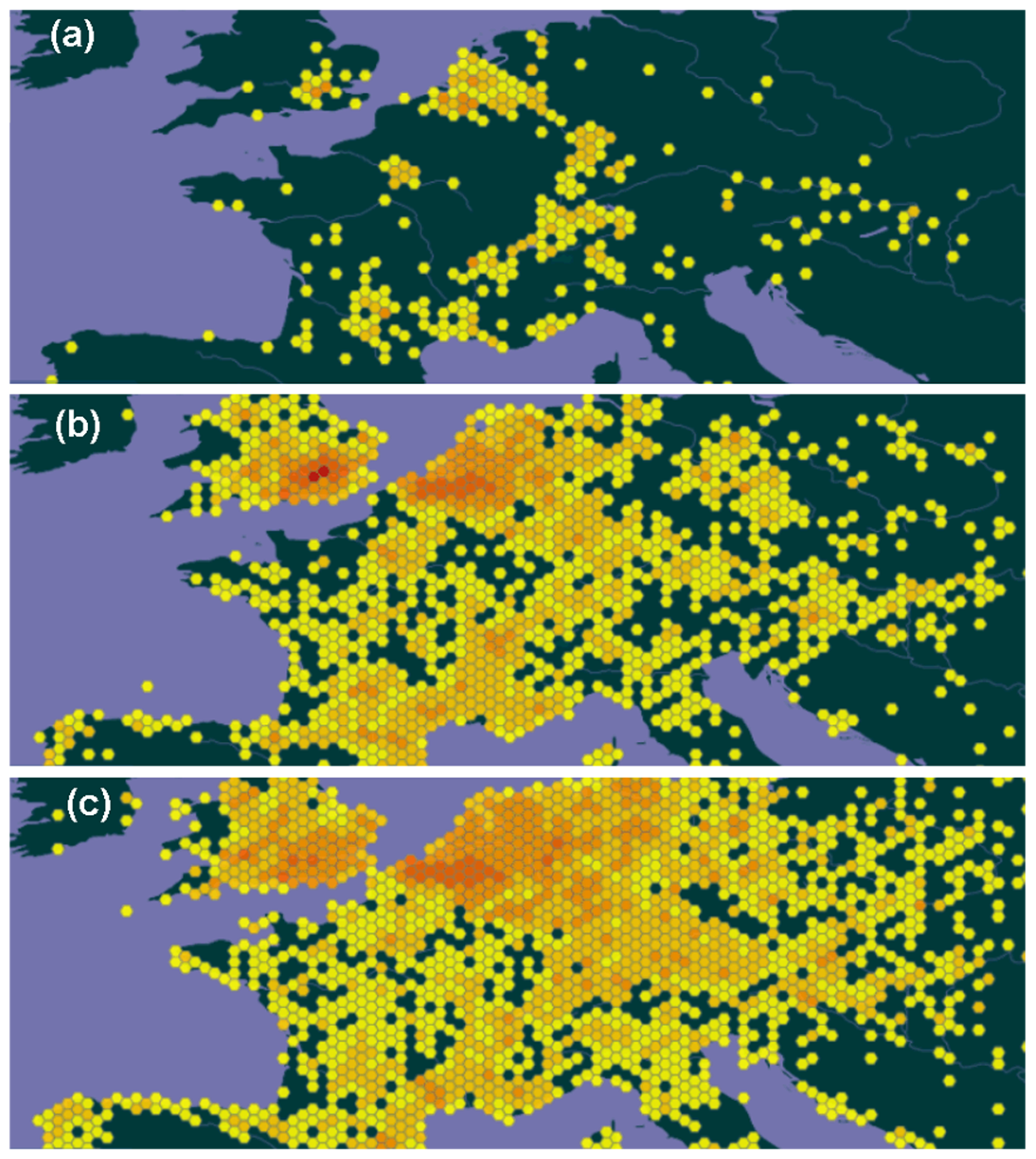
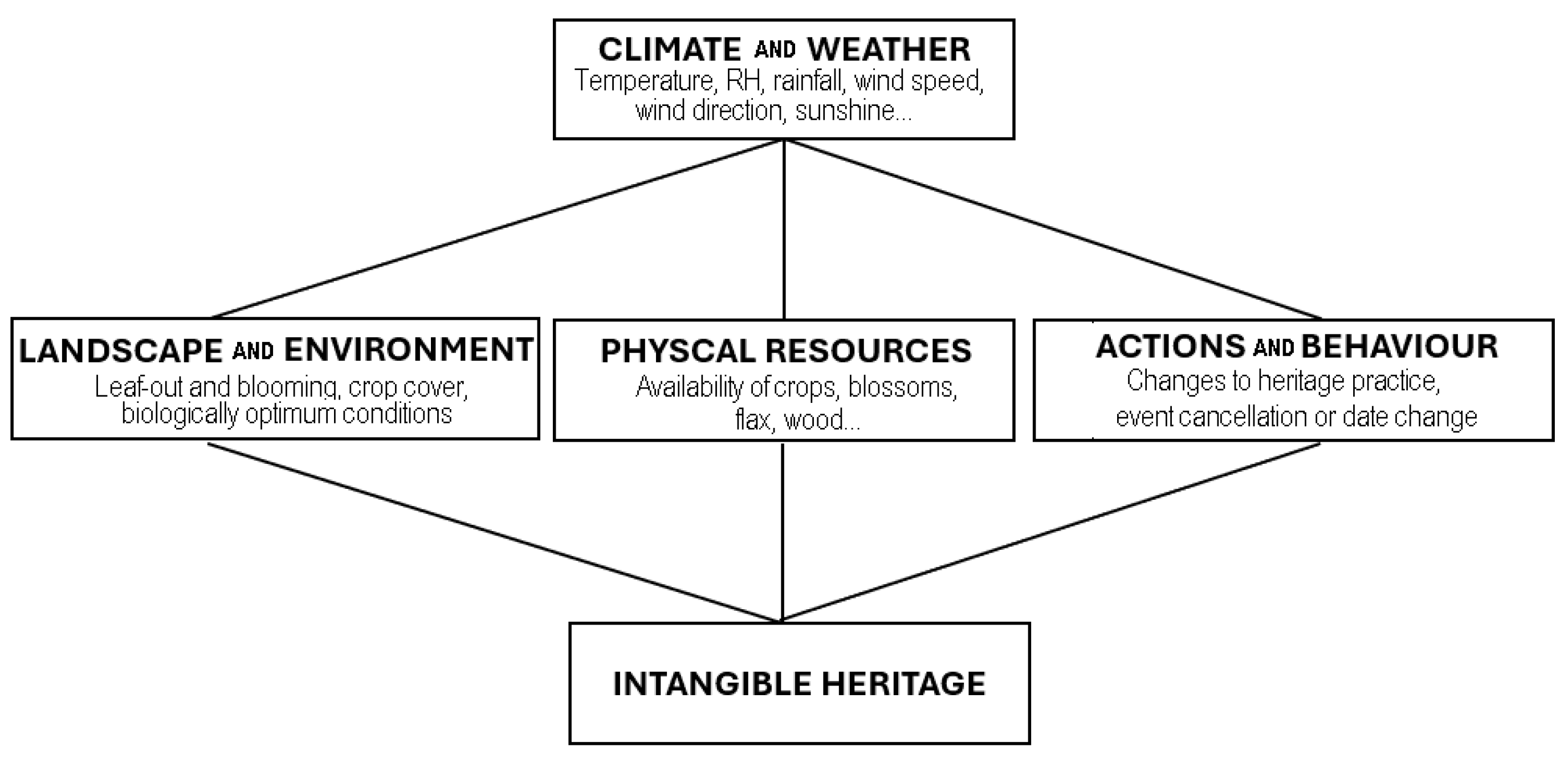
| Dataset | Timescale | Parameters | Format | Strength Limitations | URL |
|---|---|---|---|---|---|
| Archives e.g., shipping logs, diaries | Variable | Variable | Handwritten or printed documents | Rich source of past data Variable in quality and limited in spatial and temporal resolution Much data yet to be digitised | NA |
| CMIP6 model data | 1850–2100 | T, P, RH | NetCDF | Many climate parameters available at multiple temporal resolutions Output available for past and future scenarios Variable in quality and limited in spatial and temporal resolution Require computational skills | 1 |
| ERA5 reanalysis: European Centre for Medium-Range Weather Forecasts | 1940–2025 | T, P, RH | GRIB | Hourly estimates of many climate parameters Spatially complete dataset at 0.25° Requires computational skills | 2 |
| European Climate Assessment and Dataset | variable-2025 | T, P, RH | ASCII, NetCDF, maps | Data from 65 countries Daily resolution Quality controlled data series Past data—no projections for future | 3 |
| Global Biodiversity Information Facility | 1800s–2025 | Species | Maps, observations, records… | Easy to make maps; spatially and temporally tuneable Large scientific community use Need to implement quality controls on observational records No future projections | 4 |
| IPCC WGI Interactive Atlas | 1850–2100 | T, P, RH… | Maps, graphs, Excel | Easy use/access to a range of output Graphical user interface to explore past and a range of future scenarios Includes model uncertainties Less flexibility than using raw data | 5 |
| Published datasets in per reviewed literature | variable | variable | Graphs, tables, spreadsheets | Rich source of peer reviewed data May lack desired spatial or temporal resolution and flexibility in applying to different circumstances | NA |
| National climate model datasets (e.g., UKCP18) | variable | T, P, RH… | NetCDF | Many climate parameters available at high spatial and temporal resolution Output available for past and future scenarios Output limited to a defined geographical areas Require computational skills | 6 |
| World Bank Climate Change Knowledge Portal | 1850–2100 | T, P, RH… | Excel, maps, Graphs… | Easy to use and range of output Spatial resolution limited to provinces Limited temporal scales (annual or seasonal) | 7 |
Disclaimer/Publisher’s Note: The statements, opinions and data contained in all publications are solely those of the individual author(s) and contributor(s) and not of MDPI and/or the editor(s). MDPI and/or the editor(s) disclaim responsibility for any injury to people or property resulting from any ideas, methods, instructions or products referred to in the content. |
© 2025 by the authors. Licensee MDPI, Basel, Switzerland. This article is an open access article distributed under the terms and conditions of the Creative Commons Attribution (CC BY) license (https://creativecommons.org/licenses/by/4.0/).
Share and Cite
Richards, J.; Brimblecombe, P. Climate Pressures on Intangible Heritage. Heritage 2025, 8, 407. https://doi.org/10.3390/heritage8100407
Richards J, Brimblecombe P. Climate Pressures on Intangible Heritage. Heritage. 2025; 8(10):407. https://doi.org/10.3390/heritage8100407
Chicago/Turabian StyleRichards, Jenny, and Peter Brimblecombe. 2025. "Climate Pressures on Intangible Heritage" Heritage 8, no. 10: 407. https://doi.org/10.3390/heritage8100407
APA StyleRichards, J., & Brimblecombe, P. (2025). Climate Pressures on Intangible Heritage. Heritage, 8(10), 407. https://doi.org/10.3390/heritage8100407







